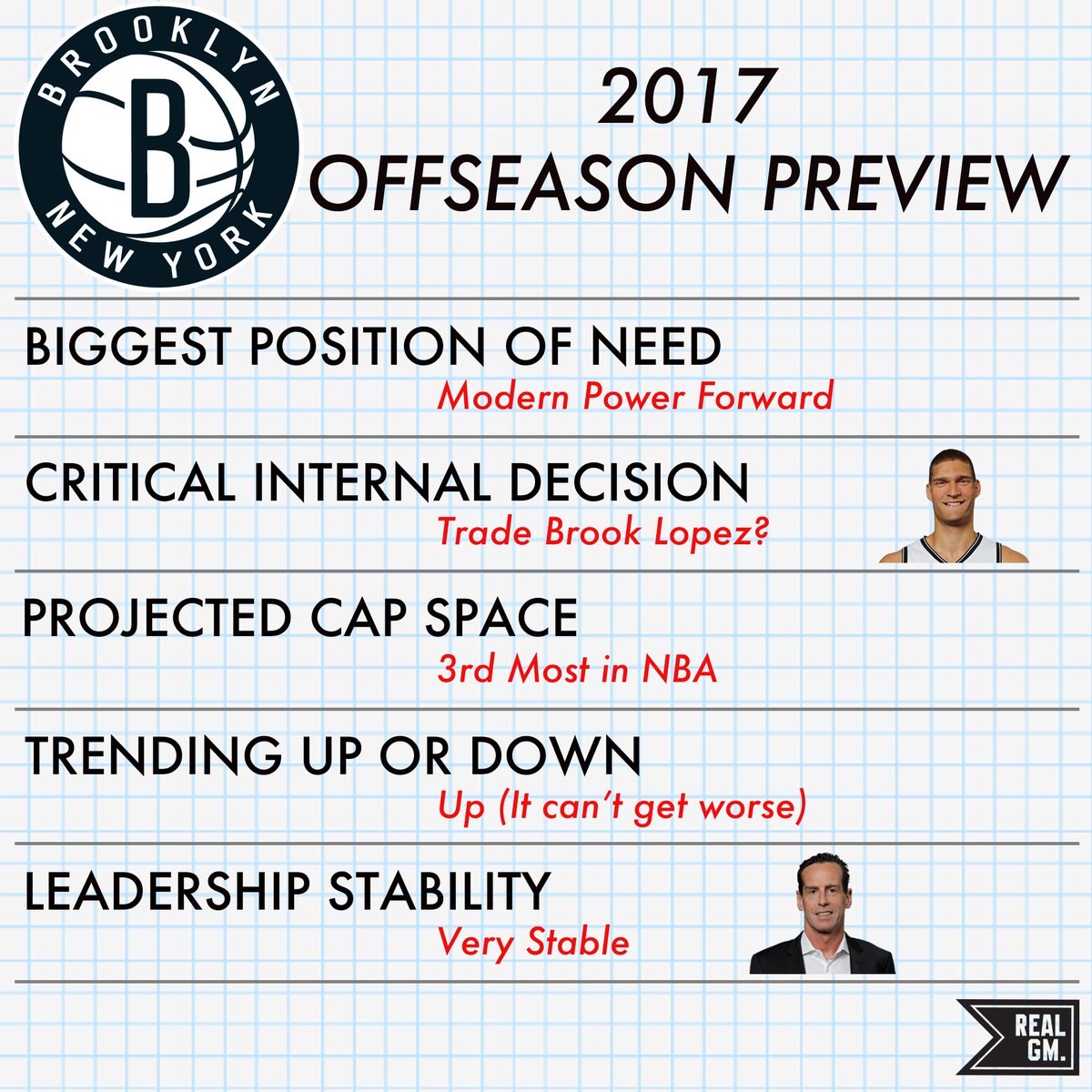Despite it seeming like an interminable rebuild, the Brooklyn Nets are actually just completing year two of being out of the playoffs. Brooklyn is a near lock to finish at the bottom of the NBA standings and head into the lottery with the best odds at the first overall pick. Unfortunately, whatever pick Brooklyn lands will be swapped with the Celtics' pick, as the Nets fulfill their next to last obligation from the 2013 trade that delivered Kevin Garnett, Paul Pierce and Jason Terry to Brooklyn for three first round picks and a swap rights in 2017.
As bleak as that might seem for Brooklyn, to finish as the worst team in the NBA and not even have a pick to show for it, things aren’t quite that bad. The Nets have several things going for them that makes their situation brighter than one might expect.
First up is the leadership at the top of the franchise. The front office, led by General Manager Sean Marks and Assistant General Manager Trajan Langdon, has been given the leeway to proceed with a proper rebuild. Despite owner Mikhail Prokhorov’s initial bluster when he entered NBA team ownership, he’s been largely hands off in recent years. Prokhorov is letting Marks and Langdon direct the rebuild in the way they best see fit, as opposed to ordering high priced signings of questionable talent that would win more games short term, while hampering things further down the road.
One of Marks’ early moves was to hire Kenny Atkinson as his head coach. Atkinson, despite never being a head coach before, has done a credible job under tough circumstances. He has the Nets playing hard night in and night out and has implemented a modern system. The Nets play at a fast pace, launch a lot of three-pointers (fourth most in the NBA as of this writing) and get to the free throw line around league average. As the talent level of the team improves, the Nets style may prove to be a winning one, not unlike the current strategy employed by the Houston Rockets.
As for that talent level, it isn’t quite as deficient as some would have you believe. The Nets were aggressive in the offseason and continued that aggression in season, as they rebuild. Over the summer, Marks’ big move was to trade Thaddeus Young to the Indiana Pacers for a first round pick. With that pick, the Nets drafted Caris LeVert, who was coming off a broken foot and hadn’t played since the middle of his senior year at the University of Michigan. It took LeVert nearly a quarter of the season before he was ready to play, but the pick looks like a good one. He’s averaging 7.7 PPG on 45% shooting and has shown a decent three-point shot at nearly 32%. He also boasts a 13.9% assist rate, which isn’t bad for a young wing. Most importantly, LeVert has been starting for most of the last month and hasn’t looked overwhelmed. The Nets have a keeper in him.
Brooklyn used their second round pick on combo guard Isaiah Whitehead and he’s proven well worth it. While his shot still needs work, Whitehead has shown enough ability that he should be a third or fourth guard as the Nets compile better talent across the roster. Not bad for a guy drafted in the middle of the second round.
Following the draft, the Nets played it safe in free agency. They signed Jeremy Lin, Trevor Booker, Randy Foye, Justin Hamilton, Joe Harris, Greivis Vasquez and Luis Scola to short term deals for relatively little money after their initial more aggressive offers for restricted free agents were matched. Every move they made was a reasonable flyer on a good, not great player. Vasquez was injured and waived fairly early on and Scola after the Trade Deadline, but the rest remain. All are signed for sensible money next year, minus Foye, who is a free agent.
These players being signed for next season is arguably just as important off the court as it is on the floor. All could be trade pieces, due in equal parts to their ability to play and being signed to sound contracts. Players like Lin or Booker could easily return good value for the Nets, either over the summer or in season. Marks traded Bojan Bogdanovic to Washington for a first round pick at this year’s deadline and could do the same with Lin or Booker. If they were on a questionable contract, the opportunity to get value in a trade would be far lesser.
The Nets' other moves were made to try and catch lightning in a bottle. They signed Spencer Dinwiddie and Quincy Acy in season to deals that are non-guaranteed for 17-18. Both have played relatively well and give Brooklyn low cost fillers at the back end of the roster.
Bringing it forward to this summer, Brooklyn will have two first round draft picks. Both are expected to be in the mid to late 20s, pending where Washington (which they got from the Bogdanovic trade) and Boston (from the swap) land. In a deep draft, Brooklyn should be able to land a player like LeVert that can help, but maybe not be a star, immediately.
Following the draft, the Nets will have among the most cap space in the NBA. They are one of only two teams, along with Philadelphia, assured of having cap space this summer. Most projections have the Nets setting somewhere between $24 and $30 million in space. More than enough to pursue a max offer with a free agent. Last summer the Nets chased restricted free agents Tyler Johnson and Allen Crabbe and are known to be fond of Detroit Pistons guard Kentavious Caldwell-Pope, who is a restricted free agent this summer. A player like Tim Hardaway Jr., who is considered a slightly lesser version of Caldwell-Pope, could be another restricted free agent target. If Brooklyn wants to go a little bigger, they could consider Otto Porter or Kelly Olynyk on the restricted market. Even if the Nets miss out like they did with Johnson and Crabbe, they will put other teams in a tough decision on deciding to match or not. And, in the case of Boston especially, it could remove some cap space from the market.
Beyond restricted free agents, the Nets will probably target other under-market veterans on reasonable contracts for one to two years. Players like Jodie Meeks, Ersan Ilyasova, Omri Casspi, and Tyrke Evans fit the mold here. It isn’t reasonable to expect Brooklyn to be in the mix for star free agents like Gordon Hayward, Blake Griffin or Kyle Lowry. They simply aren’t there on the rebuild arc yet and those players are going to want to be in “win now” situations.
The Net biggest need this summer is probably to find a modern power forward. Booker started for a large chunk of the season and is a nice energy player, but he’s best fit in a bench role. Brooklyn moved on to starting Rondae Hollis-Jefferson, but he’s not really a power forward and can’t really stretch floor reliably. Finding a power forward who is either a supreme athlete, good shooter, or ideally both, is paramount.
The second biggest need, or decision if you will, is whether or not they hang on to Brook Lopez. Lopez is entering the final year of his contract and completely re-made his game under Atkinson. Entering 2016-17, Lopez had attempted 31 total three-pointers. This season he’s made 118 of them. And he’s shooting at a 35% clip from behind the arc. While his overall field goal percentage is down, Lopez has a career-best 58% true shooting percentage in seasons where he’s played the whole year. Adding the long ball to his repertoire has made Lopez a better fit for the modern NBA. He can still get inside and score as well, as he’s shooting 67% at the rim.
The question is do the Nets need him? It is expected they’ll listen to trade offers for the big man, but they won’t give him away by any means. Last season the demands were reported to be two first round picks and by the deadline they had lessened to a first and a second. If a team finds themselves in need of a true center, Brooklyn will have a chance to move on from their franchise big man of nearly a decade. No matter what, barring a miraculous turnaround that has them in playoff contention come the Trade Deadline, the Nets will probably take what they can get, similar to Bogdanovic, versus risking losing Lopez for nothing.
Overall, it might not be the most exciting offseason for Brooklyn, but that is okay. Excitement only lasts a short time and often turns into something else entirely, as the Nets are all too familiar with. By staying the course and taking shots at restricted free agents, low-risk signings of unrestricted free agents and building through the draft, the Nets will get back to being a playoff team. While it isn’t quite no sleep till Brooklyn just yet, those days might not be too far off.
Offseason Details
Guaranteed Contracts (8): Trevor Booker, Justin Hamiton, Rondae Hollis-Jefferson, Caris LeVert, Jeremy Lin, Brook Lopez, Andrew Nicholson, Isaiah Whitehead
Partial/Non-Guaranteed Contracts (4): Quincy Acy, Spender Dinwiddie, Joe Harris, Sean Kilpatrick
Potential Free Agents (2): Randy Foye (UFA), K.J. McDaniels (RFA – Team Option)
“Dead” Money on Cap (1): $5,474,787 (Deron Williams)
First Round Draft Pick(s) (as of 3/24/17): Pick #24, Pick #26
Maximum Cap Space: $35,603,909
Projected Cap Space: $26,071,683




